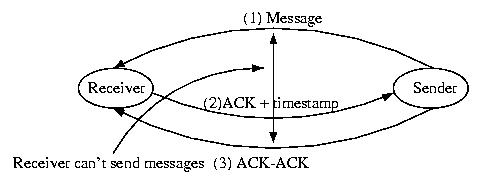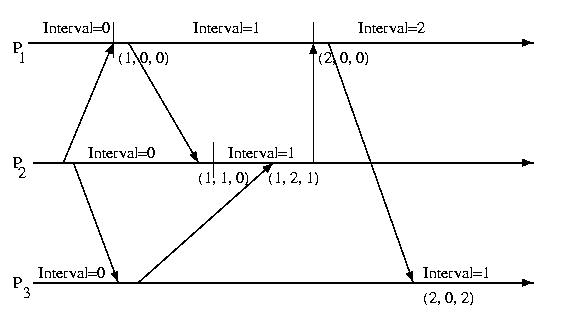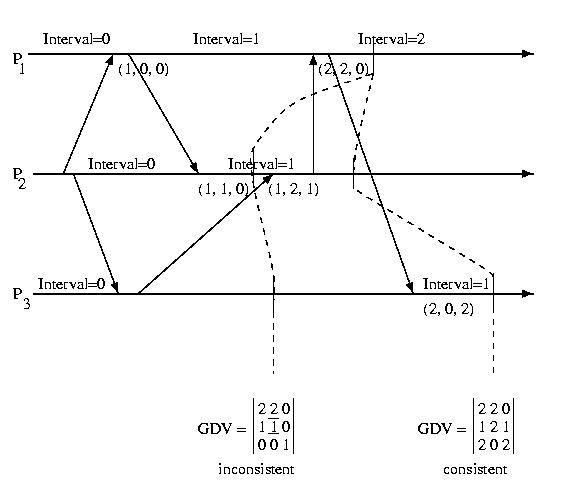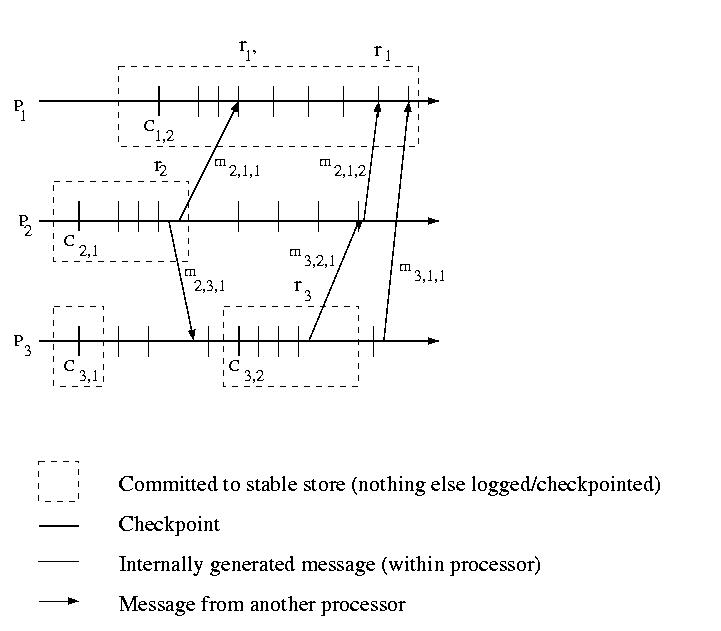Our examples above assumed that messages would be logged by the
receiver. Most of our discussion of logging will, in fact, be focused
on receiver-based techniques. But, before we dive into these, let's
take a quick look at logging messages at the sender.
Sender based logging is very important in those cases where receivers
are thin or unreliable. In other words, we would want to log messages
on the sender if the receiver does not have the resources to maintain
the logs, or if the receiver is likely to fail. This might be
the case, for example, if the sender is a reliable server and the
receiver a portable mobile device.
So, let's assume that each sender logs each message it sends and
that the receiver logs nothing. Recovery isn't quite so easy as
having each sender play back its logs. Although each sender can play the
messages back in the same order in which they were dispatched,
there is no way to order the messages among the senders.
One solution to this problem is to follow the following protocol:
- The sender logs the message and dispatches it.
- The receiver receives the message and ACKs it with the current
time (local to the receiver).
- The sender adds the timestamp contained in the ACK to its log
entry to the message -- the message is now fully logged
If the above protocol is followed, the timestamp can be used to
ensure that messages from multiple servers are processed by the
receiver in the proper order. This is because all of the timestamps
were assigned by the client, so clock skew is not a problem.
(The timestamp can be as simple as a receive sequence number).
But there is one small problem. Consider Sender
sending a Message to Receiver. Now consider the same Sender
sending a message, m', to Receiver. If the Receiver fails
before it ACKS m, it is unknown whether or not m was received by
the Receiver before the Sender dispatched m' -- we can't
establish whether or not a causal relationship exists.
One solution to this problem is to require that the sender send an
ACK-ACK to the receiver. If the receiver blocks until it receives
the ACK-ACK, the order of the messages will be clear.

Given this protocol, recovery is very, very straight-forward. Upon
reinitialization, the failed receiver sends a message to all other hosts
in the system with the number of the last message that it remembers ACKing.
The senders then replay their logs, including the receiver-assigned sequence
numbers. The receiver applies these messages in the order of their
sequence number. The senders know to ignore the responses to these messages.
This process leads to a very simple, uncomplicated recovery.
In order to recover from failure given asynchronous logging,
we need some way for the processors to keep track of their current
state, some way for them to communicate it to each other, and some
way of evaluating the state of the system.
The approach that we'll discuss makes use of direct dependency
vectors. Before defining a DDV, we need to define an
interval. An interval on a processor is the period of
time between receiving two messages. The intervals on a particular
processor are sequentially numbered and given an interval index.
Each time a processor sends a message, it also sends its current interval.
On the receiving process, a direct dependency vector is associated with
the event. This vector contains the processor's understanding of the
interval on all processors. This information may be out of date, and does
not take gossip into account. One processor is only informed about
another processor's interval, if it directly receives a message
from that processor. It is important to pay attention to the
fact that the interval must be directly communicated from one
process to another -- it is not transitive and cannot be communicated
indirectly. A message from processor X to processor Y only contains
X's interval, not the DDV present on X.
The diagram below illustrates the intervals and DDVs associated with
each processor.

We can define the global state of the system at any point in time
to be the collection of the DDVs at each processor. We can organize
this state into a Global Dependency Matrix (GDM). We'll
follow your textbook's nomenclature and give this the somewhat
misleading label GDV.
The diagram below shows the GDV at two different points in time:

Notice that the first GDV is inconsistent. The DDV component of the GDV
from Processor 1 indicates that Processor 1 has received
a message from Processor 2 indicating that Processor 2 is in Interval 2.
But the DDV vector within the GDV from Processor 2 indicates that Processor
2 is in Interval 1. This indicates an inconsistent recovery line.
The second GDV does not have any inconsistencies -- it is consistent
recovery line.
We can check to see if a GDV is valid, by looking at each DDV one at a time.
For each entry in a consistent DDV, the interval shown for another procesor
must be less than or equal to the interval that that processor's DDV
within the GDV contains for itself.
GDV(p)[q] <= GDV(q)[q], 1<=p, q<=M
In other words, no processor can have received a message from
another processor originating in an interval in advance of that processor's
current interval.
So, we know what an inconsistent state looks like, but how do we find
a recovery line? We start out with the initial state of all processors
composing a valid recovery line. We store this in a vector, RV, that
contains the interval index for each processor -- these will initially
be 0.
Then each time a processor commits enough log entries or checkpoints
to make a new interval stable, it sends this information to a
central server that tries to advance the recovery line.
To find the recovery line, the coordinator keeps a matrix with the
current recovery line, and a bin of recent interval updates that
are are not a part of the current recovery line. The coordinator then
applies the recent update to the matrix and checks for consistency.
It also attempts to include as many of the other recent updates from
the bin as possible. If it is unable to incorporate the most recent
update into a consistent recovery lines, it adds it to the bin --
a future update may make it usable.
For those who would like a more formal look at one possible implementation
of this algorithm, the following pseudo-code might be helpful:
find_recoverable (RV, p, k)
TRV = RV // Make a copy of the current recover line (RV)
TRV[p] = k // advance the interval for processor p to k
// in this temporary copy -- a candidate
// that needs to be check for inconsistency
// Compare the DDV for each processor to the entries in TRV,
// a temporary and optimistic GDV. Record inconsistencies
// in Max
for q = 1 to M // M is the number of processors
Max[q] = max(TRV[q], DDV(p,q)[q])
// Try to resolve inconsistencies by looking at stable intervals
// that we haven't been able to use, yet (previously other
// processors weren't stable in sufficiently advanced intervals)
While there is a q such that Max[q] > TRV[q]
Let l be the minimum index such that l >= Max[q] and stable(l)
If no such l exists // if we can't fix the problem with these states
return (fail) // we're going to have to try again later to advance
TRV[q] = l // If we can fix this problem, optimistically
// add this interval to the TRV
for r = 1 to M // And recompute the Max matrix so that we
// can check for new incocnsistencies
Max[r] = max(Max[r], DDV(q,l)[r])
// There are no inconsistencies, sThere are no inconsistencies,
// so make the candidate recovery line, the real thing.
RV = TRV
return (success)
One might observe that it isn't necessary for a processor to log
every message. It only needs to log those messages that have originated
from processors that have taken checkpoints more recently than it has.
If processors with less recent checkpoints were to fail, they would be
forced to roll back prior to the message's sending, anyway.
One approach for this problem is for each processor to give a sequence
number to its checkpoints (as we have done before), and to keep a vector
containing its best understanding of the most recent checkpoints on
all other processors.
If each time a message is sent, the current recovery line (CRL) is sent
with it, a processor can determine if it is ahead of, or behind, the
sender with respect to making checkpoints by comparing its checkpoint
sequence number, to the sequence number of the sender in CRL received with
the message. If the sender is ahead, the receiver will log the message.
If not, it won't worry about it.



